check engine CHEVROLET CAMARO 1998 4.G Workshop Manual
[x] Cancel search | Manufacturer: CHEVROLET, Model Year: 1998, Model line: CAMARO, Model: CHEVROLET CAMARO 1998 4.GPages: 402, PDF Size: 21.2 MB
Page 282 of 402
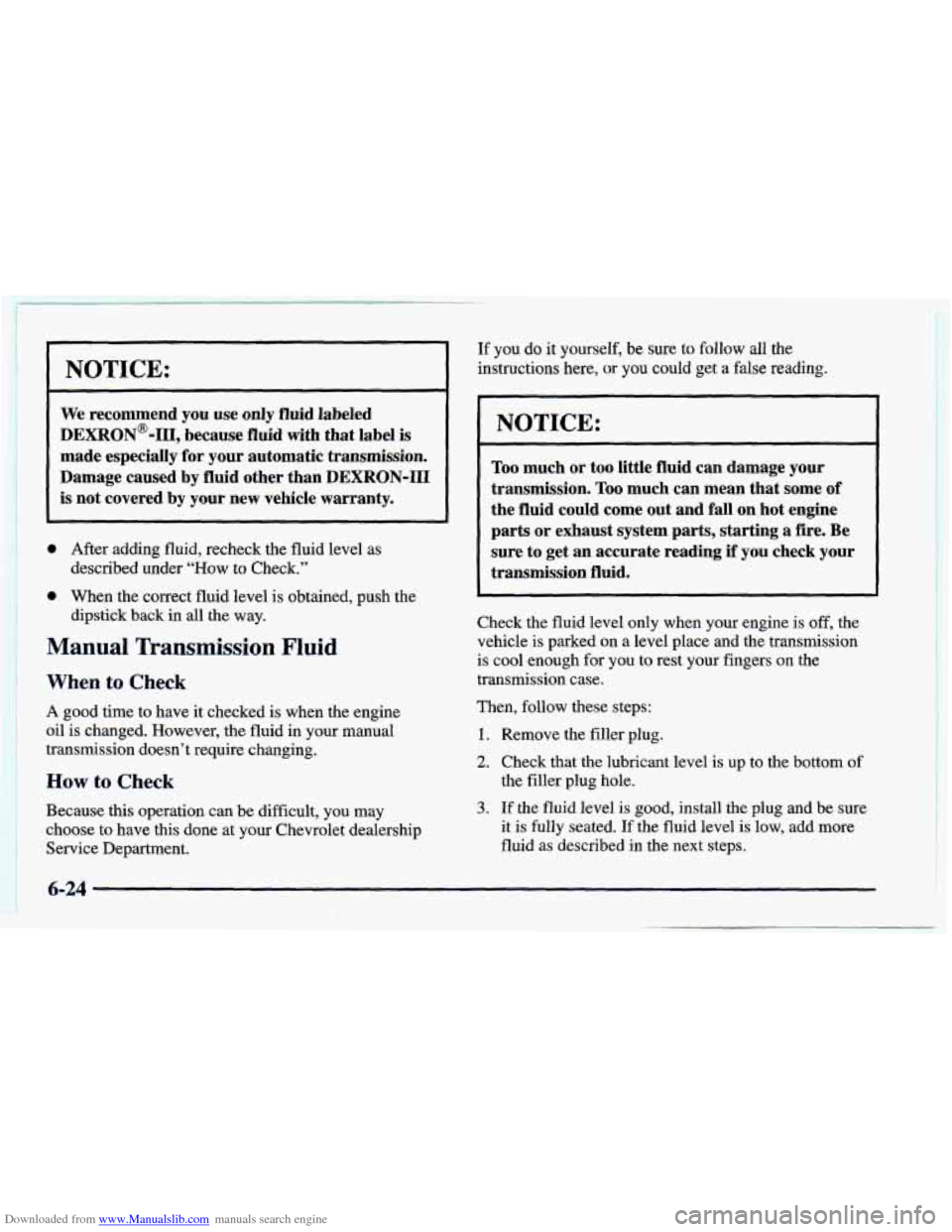
Downloaded from www.Manualslib.com manuals search engine NOTICE:
We recommend you use only fluid labeled
DEXR0N’-III, because fluid with that label
is
made especially for your automatic transmission.
Damage caused
by fluid other than DEXRON-111
is not covered by your new vehicle warranty.
0 After adding fluid, recheck the fluid level as
0 When the correct fluid level is obtained, push the
described
under “How
to Check.”
dipstick back in
all the way.
Manual Transmission Fluid
When to Check
A good time to have it checked is when the engine
oil is changed. However, the fluid in your manual
transmission doesn’t require changing.
How to Check
Because this operation can be difficult, you may
choose to have this done at your Chevrolet dealership
Service Department.
If you do it yourself, be sure to follow all the
instructions here, or you could get a false reading.
NOTICE:
Too much or too little fluid can damage your
transmission.
Too much can mean that some of
the fluid could come out and fall on hot engine
parts or exhaust system parts, starting a fire.
Be
sure to get an accurate reading if you check your
transmission fluid.
Check the fluid level only when your engine is off, the
vehicle
is parked on a level place and the transmission
is cool enough for you to rest your fingers
on the
transmission case.
Then, follow these steps:
1. Remove the filler plug.
2. Check that the lubricant level is up to the bottom of
the filler plug hole.
3. If the fluid level is good, install the plug and be sure
it is fully seated. If the fluid level is
low, add more
fluid as described in the next steps.
6-24
Page 283 of 402
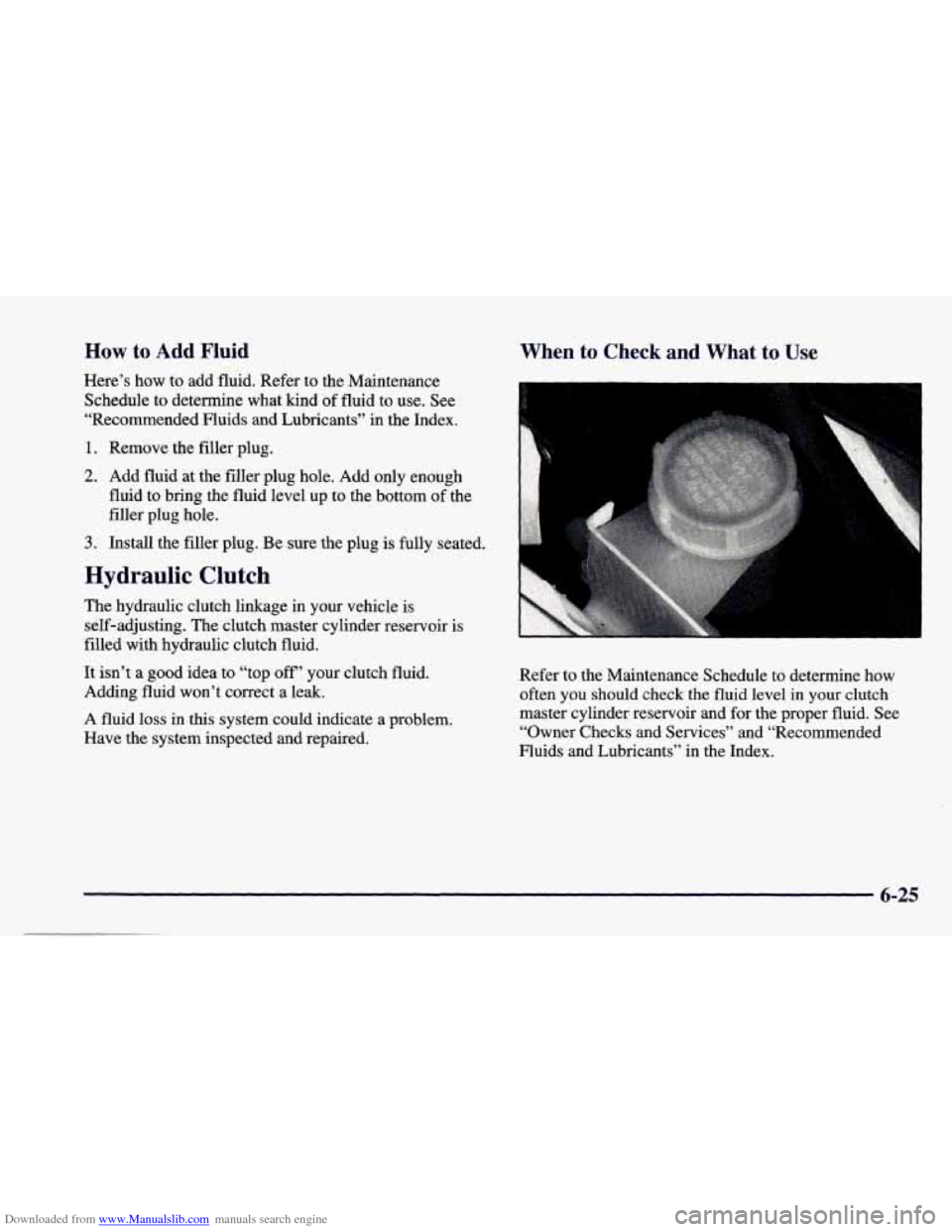
Downloaded from www.Manualslib.com manuals search engine How to Add Fluid
Here’s how to add fluid. Refer to the Maintenance
Schedule to determine what kind of fluid to use. See
“Recommended Fluids and Lubricants” in the Index.
1. Remove the filler plug.
2. Add fluid at the filler plug hole. Add only enough
fluid to bring the fluid level up to the bottom of the
filler plug hole.
3. Install the filler plug. Be sure the plug is fully seated.
Hydraulic Clutch
The hydraulic clutch linkage in your vehicle is
self-adjusting.
The clutch master cylinder reservoir is
filled with hydraulic clutch fluid.
It isn’t a good idea to “top off’ your clutch fluid.
Adding fluid won’t correct a leak.
A fluid loss in this system could indicate a problem.
Have the system inspected and repaired.
When to Check and What to Use
Refer to the Maintenance Schedule to determine how
often you should check the fluid level in your clutch
master cylinder reservoir and for the proper fluid. See
“Owner Checks and Services” and “Recommended
Fluids and Lubricants” in the Index.
6-25
Page 284 of 402
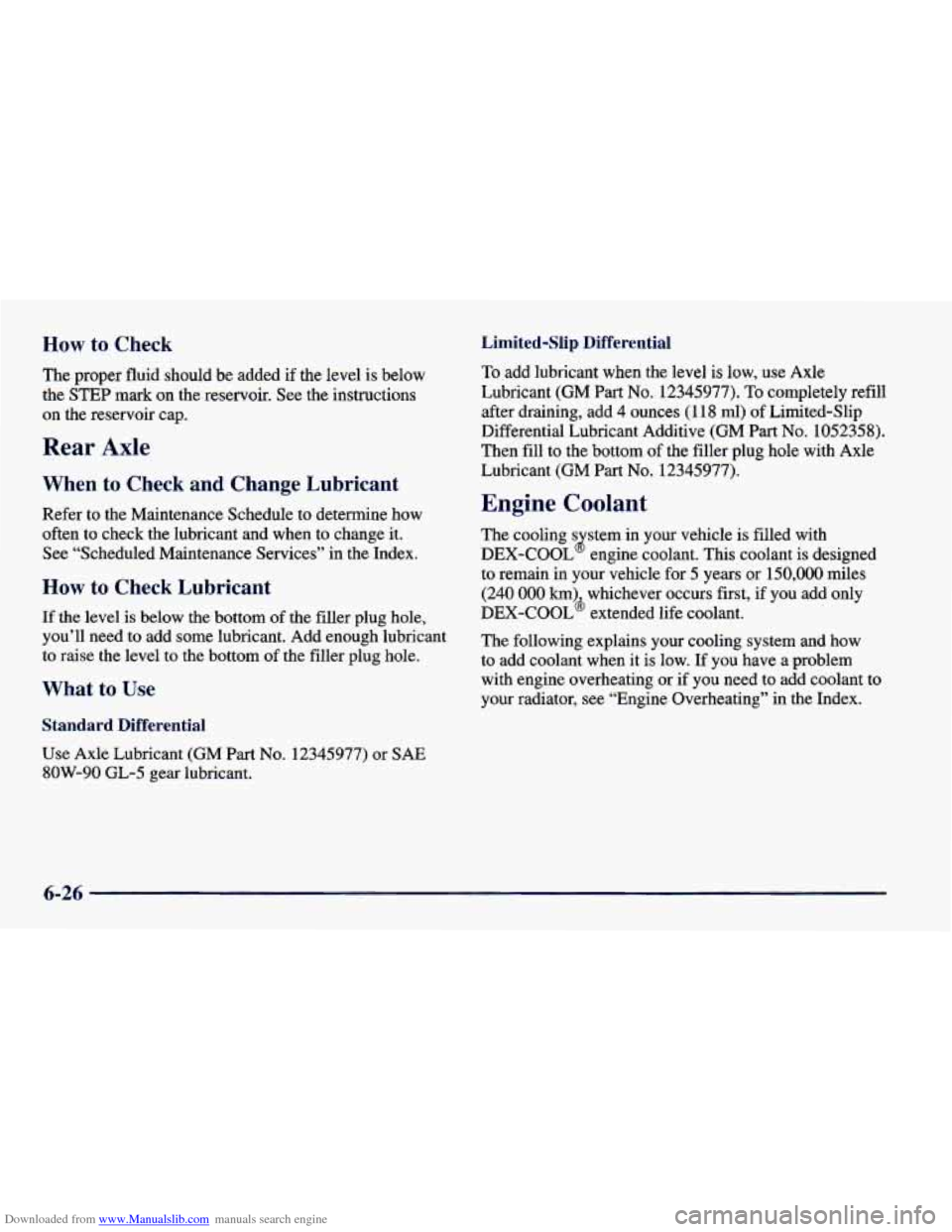
Downloaded from www.Manualslib.com manuals search engine How to Check
The proper fluid should be added if the level is below
the STEP mark on the reservoir. See the instructions
on the reservoir cap.
Rear Axle
When to Check and Change Lubricant
Refer to the Maintenance Schedule to determine how
often to check the lubricant and when to change
it.
See “Scheduled Maintenance Services” in the Index.
How to Check Lubricant
If the level is below the bottom of the filler plug hole,
you’ll need to add some lubricant. Add enough lubricant
to raise the level to the bottom of the filler plug hole.
What to Use
Standard Differential
Use Axle Lubricant (GM Part No. 12345977) or SAE
80W-90 GL-5 gear lubricant.
Limited-Slip Differential
To add lubricant when the level is low, use Axle
Lubricant (GM
Part No. 12345977). To completely refill
after draining, add
4 ounces (1 18 ml) of Limited-Slip
Differential Lubricant Additive
(GM Part No. 1052358).
Then fill to the bottom of the filler plug hole with Axle
Lubricant (GM
Part No. 12345977).
Engine Coolant
The cooling s stem in your vehicle is filled with
DEX-COOL engine coolant. This coolant is designed
to remain in your vehicle for
5 years or 150,000 miles
(240
000 km) whichever occurs first, if you add only
DEX-COOL’ extended life coolant.
B
The following explains your cooling system and how
to add coolant when it is low. If you have a problem
with engine overheating or
if you need to add coolant to
your radiator, see “Engine Overheating” in the Index.
6-26
Page 286 of 402
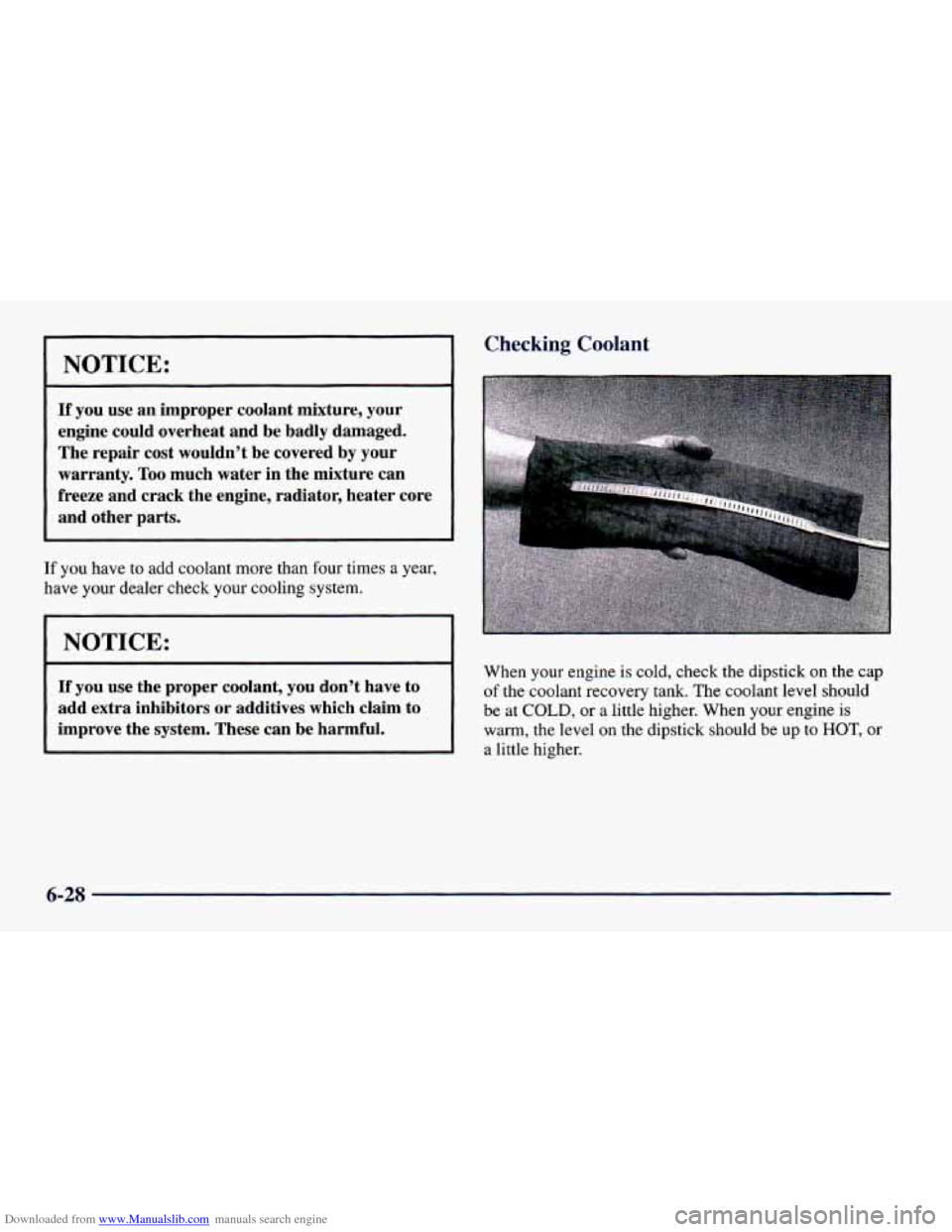
Downloaded from www.Manualslib.com manuals search engine NOTICE:
If you use an improper coolant mixture, your
engine could overheat and be badly damaged.
The repair
cost wouldn't be covered by your
warranty.
Too much water in the mixture can
freeze and crack the engine, radiator, heater core
and other parts.
If you have to add coolant more than four times a year,
have your dealer check your cooling system.
I NOTICE:
If you use the proper coolant, you don't have to
add extra inhibitors or additives which claim to
improve the system. These can be harmful.
Checking Coolant
When your engine is cold, check the dipstick on the cap
of the coolant recovery tank. The coolant level should
be at
COLD, or a little higher. When your engine is
warm, the level
on the dipstick should be up to HOT, or
a little higher.
6-28
Page 288 of 402
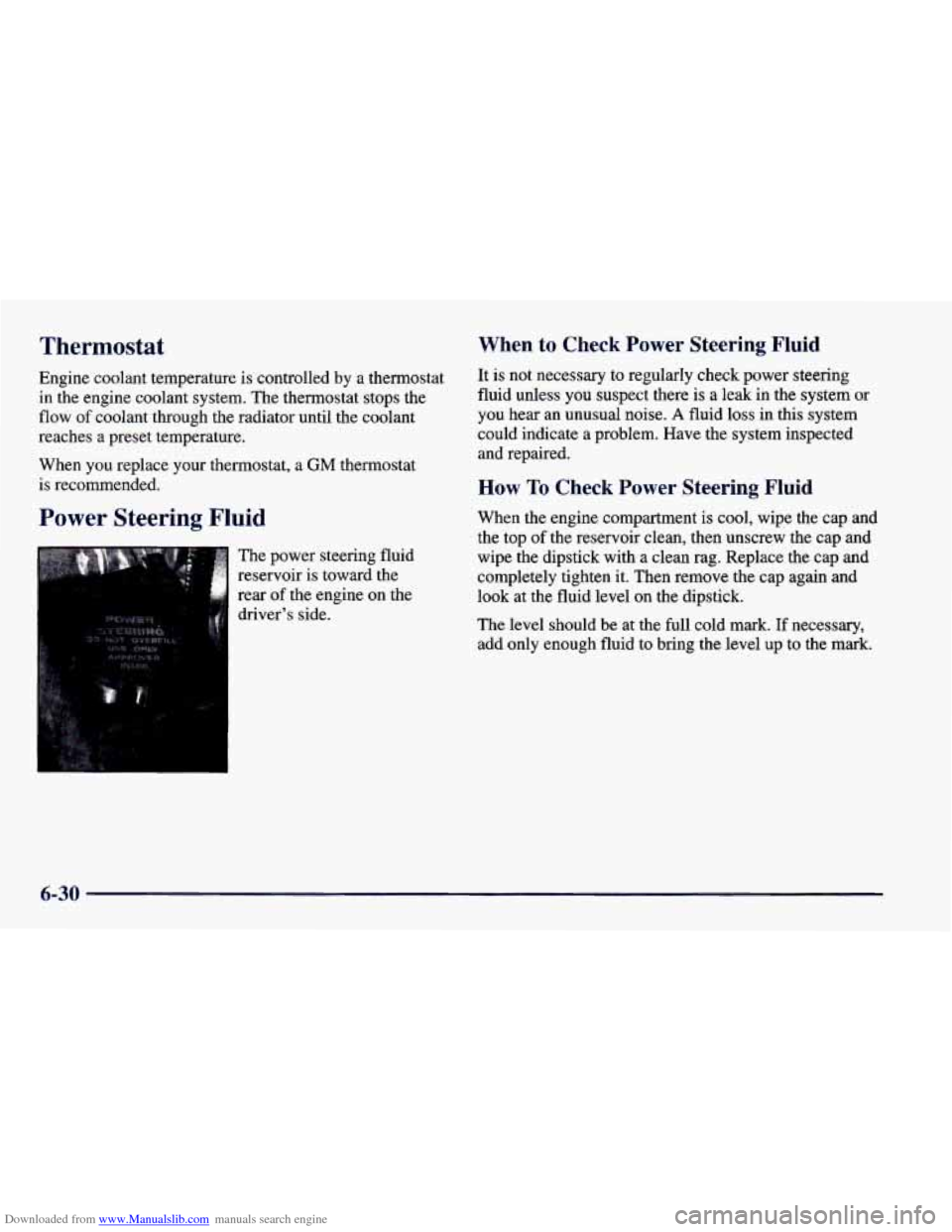
Downloaded from www.Manualslib.com manuals search engine Thermostat
Engine coolant temperature is controlled by a thermostat
in the engine coolant system. The thermostat stops the
flow
of coolant through the radiator until the coolant
reaches
a preset temperature.
When you replace your thermostat, a
GM thermostat
is recommended.
Power Steering Fluid
The power steering fluid
reservoir is toward the
When to Check Power Steering Fluid
It is not necessary to regularly check power steering
fluid unless you suspect there is a leak in the system
or
you hear an unusual noise. A fluid loss in this system
could indicate a problem. Have the system inspected
and repaired.
How To Check Power Steering Fluid
When the engine compartment is cool, wipe the cap and
the top
of the reservoir clean, then unscrew the cap and
wipe the dipstick with a clean rag. Replace the cap and
completely tighten it. Then remove the cap again and
look at the fluid level on the dipstick.
The level should be
at the full cold mark. If necessary,
add only enough fluid to bring the level up to the mark.
6-30
Page 291 of 402
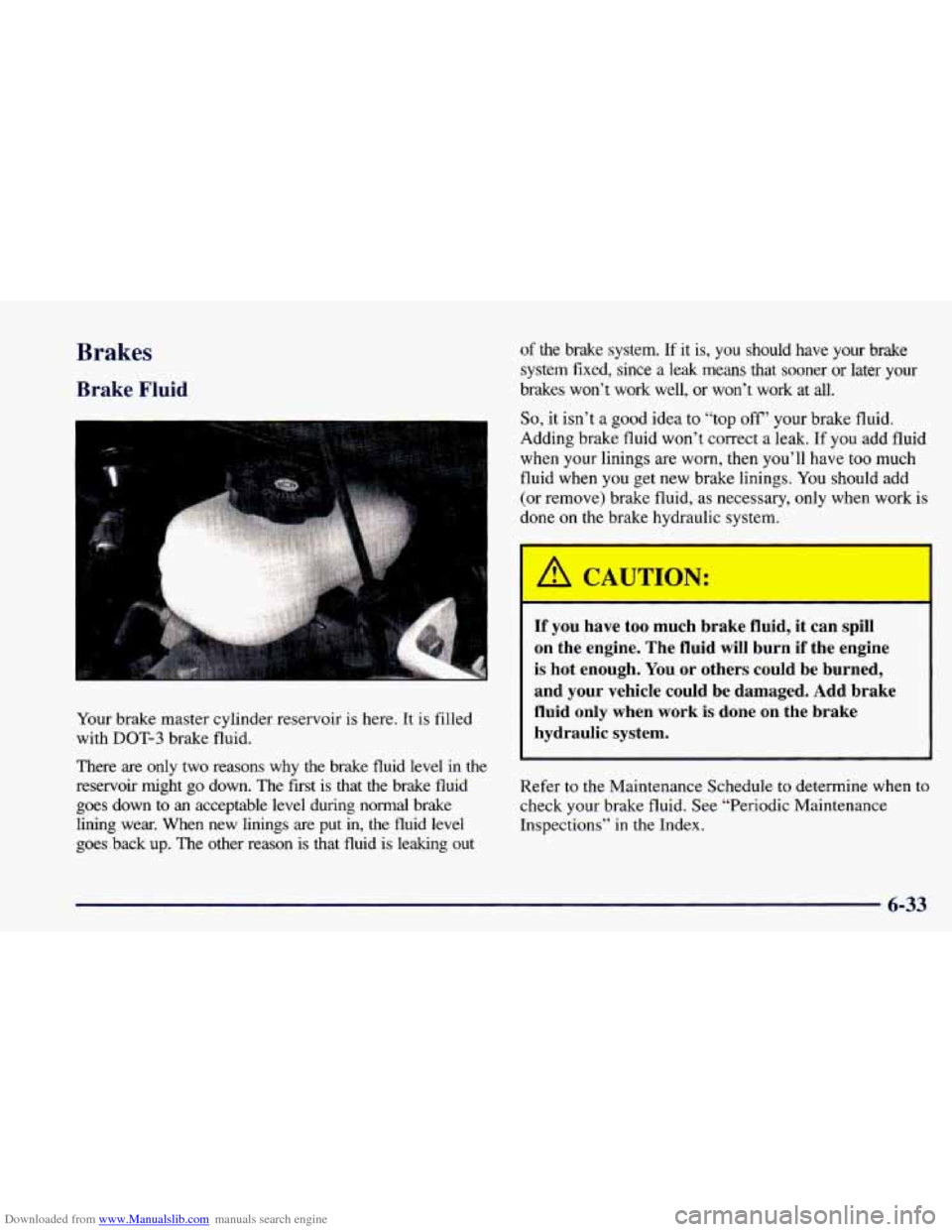
Downloaded from www.Manualslib.com manuals search engine Brakes
Brake Fluid
of the brake system. If it is, you should have your brake
system fixed, since
a leak means that sooner or later your
brakes won’t work well, or won’t work at all.
So, it isn’t a good idea to “top off’ your brake fluid.
Adding brake fluid won’t correct a leak. If you add fluid
when your linings are worn, then you’ll have too much
fluid when you get new brake linings. You should add
(or remove) brake fluid, as necessary, only when work is
done on the brake hydraulic system.
Your brake master cylinder reservoir is here. It is filled
with
DOT-3 brake fluid.
There
are only two reasons why the brake fluid level in the
reservoir might go down. The first is that the brake fluid
goes down to
an acceptable level during normal brake
lining wear.
When new linings are put in, the fluid level
goes back up. The other reason is that fluid is leaking
out
A CAUTIOP’:
F
If you have too much brake fluid, it can spill
on the engine. The fluid will burn if the engine
is hot enough.
You or others could be burned,
and your vehicle could be damaged. Add brake
fluid only when work
is done on the brake
hydraulic system.
Refer to the Maintenance Schedule to determine when to
check your brake fluid. See “Periodic Maintenance
Inspections’’ in the Index.
6-33
Page 292 of 402
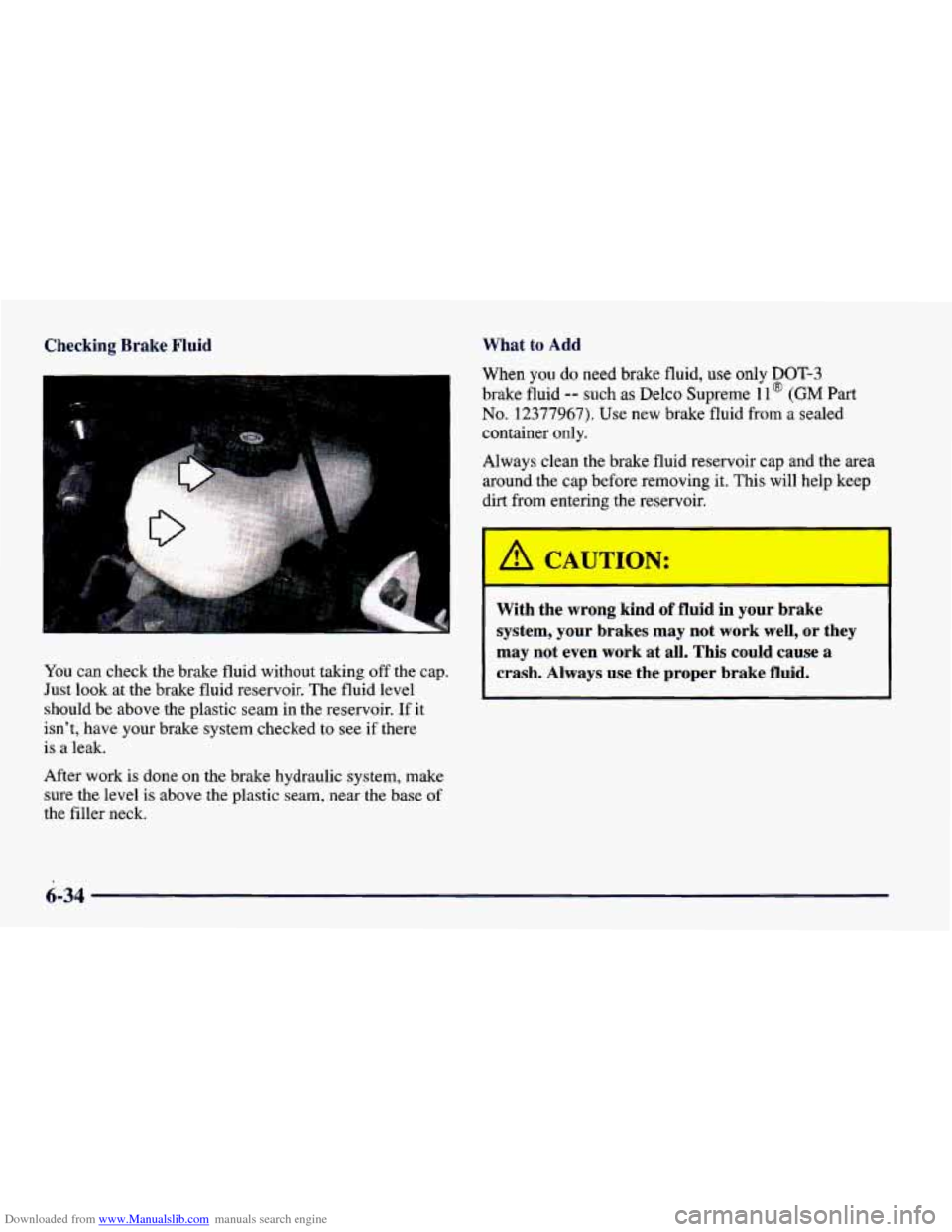
Downloaded from www.Manualslib.com manuals search engine Checking Brake Fluid
You can check the brake fluid without taking off the cap.
Just look at the brake fluid reservoir. The fluid level
should be above the plastic seam in the reservoir. If it
isn't, have your brake system checked
to see if there
is a leak.
After work is done on the brake hydraulic system, make
sure the level is above the plastic seam, near the base of
the filler neck.
What to Add
When you do need brake fluid, use only DOT-3
brake fluid -- such as Delco Supreme 11 @ (GM Part
No. 12377967). Use new brake fluid from a sealed
container only.
Always clean the brake fluid reservoir cap and the
area
around the cap before removing it. This will help keep
dirt from entering the reservoir.
I
A CAUTION:
- -
With the wrong kind of fluid in your brake
system, your brakes may not work well, or they
may not even work at all. This could cause a
crash. Always use the proper brake fluid.
6-34
Page 296 of 402
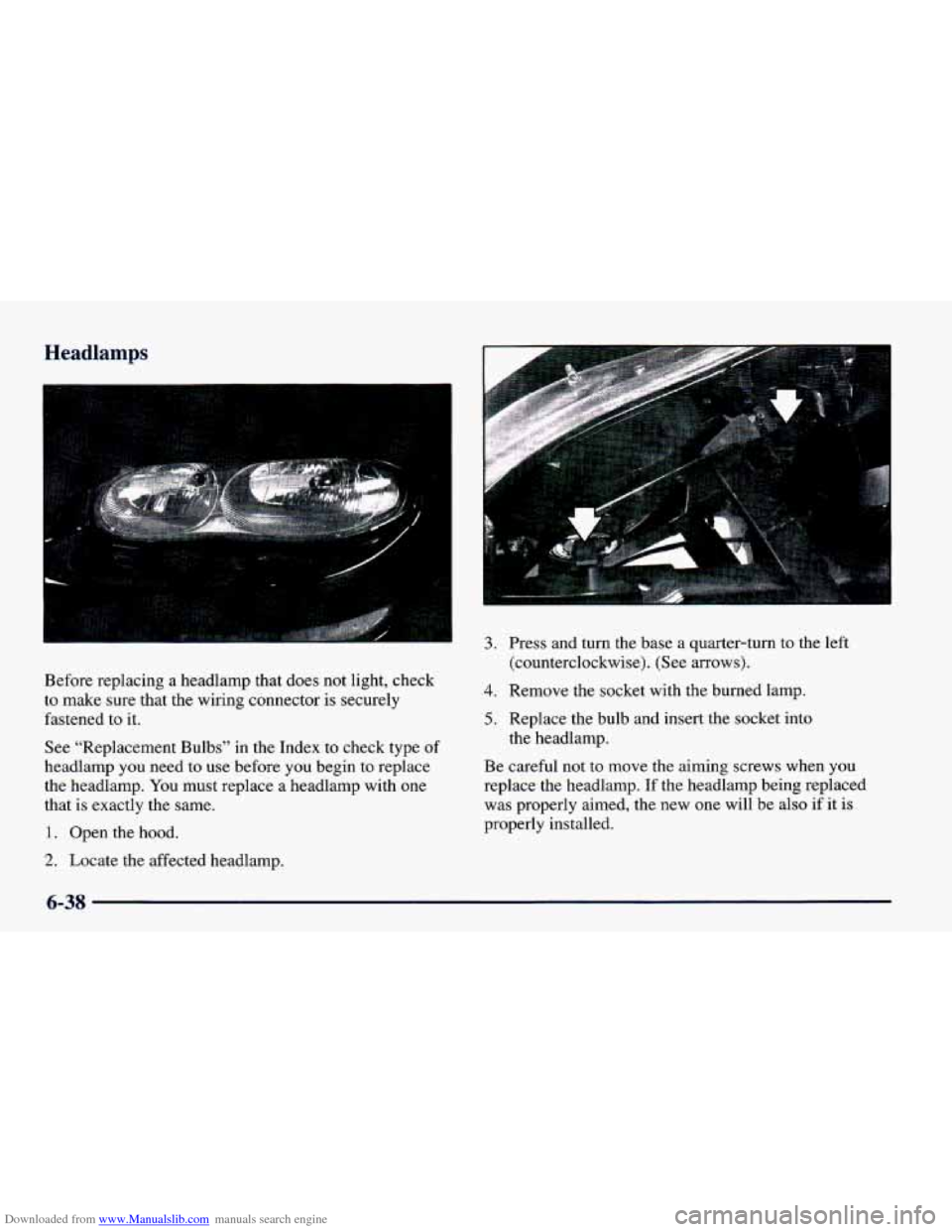
Downloaded from www.Manualslib.com manuals search engine Headlamns
3.
Before replacing a headlamp that does not light, check
to make sure that the wiring connector
is securely
fastened to
it.
See "Replacement Bulbs" in the Index to check type of
headlamp you need to use before you begin to replace
the headlamp.
You must replace a headlamp with one
that is exactly the same.
1. Open the hood.
2. Locate the affected headlamp.
4.
5.
Press and turn the base a quarter-turn to the left
(counterclockwise). (See arrows).
Remove the socket with
the burned lamp.
Replace the bulb and insert the socket into
the headlamp.
Be careful
not to move the aiming screws when you
replace the headlamp. If the headlamp being replaced
was properly aimed, the new one will be also
if it is
properly installed.
6-38
Page 301 of 402
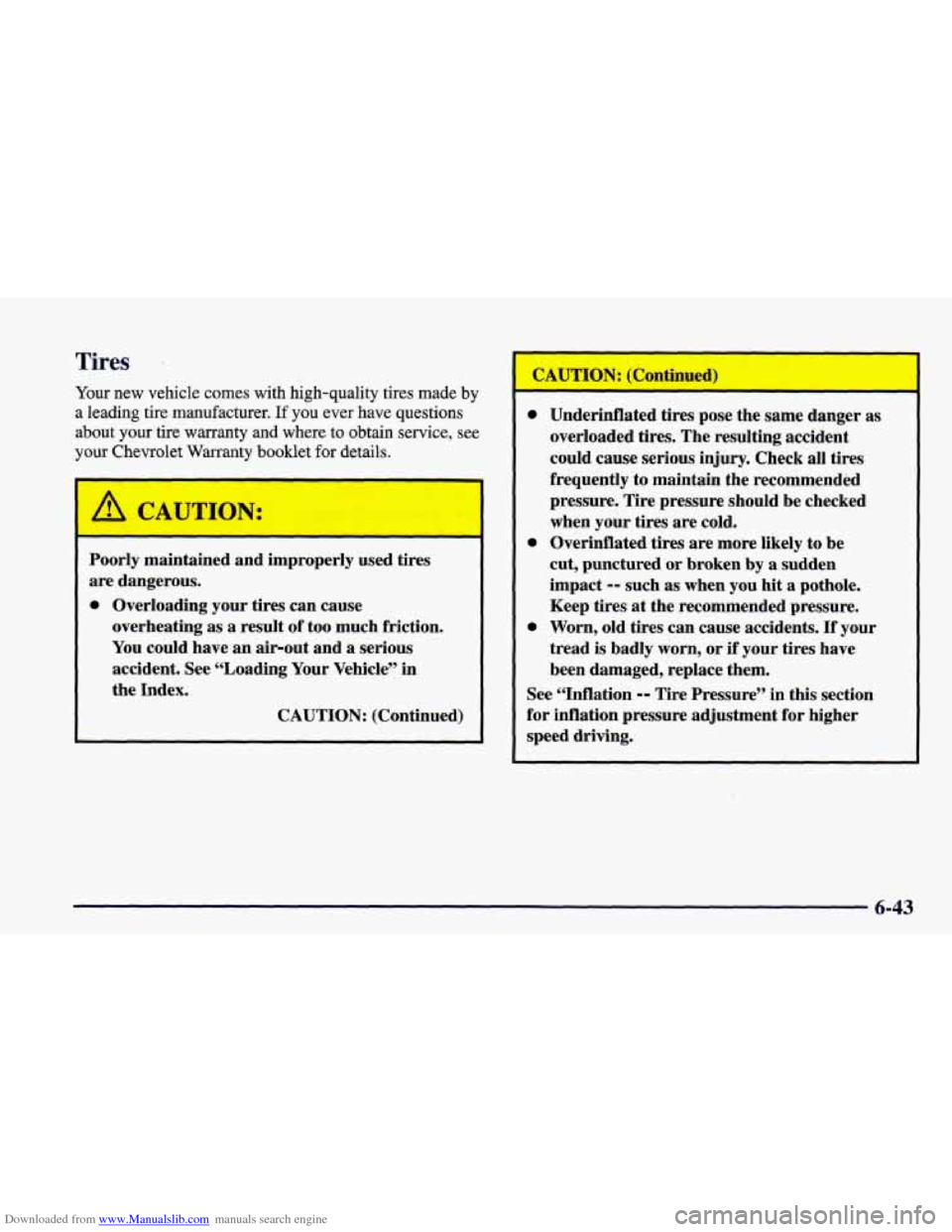
Downloaded from www.Manualslib.com manuals search engine Tires
Your new vehicle comes with high-quality tires made by
a leading tire manufacturer.
If you ever have questions
about your tire warranty and where to obtain service, see
your Chevrolet Warranty booklet for details.
’ Poorly maintained and improperly used tires
are dangerous.
0 Overloading your tires can cause
overheating as
a result of too much friction.
You could have
an air-out and a serious
accident. See “Loading Your Vehicle” in
the Index.
CAUTION: (Continued)
0
0
0
Underinflated tires pose the same danger as
overloaded tires. The resulting accident
could cause serious injury. Check all tires
frequently to maintain the recommended
pressure. Tire pressure should be checked
when your tires are cold.
Overinflated tires are more likely to be
cut, punctured or broken by
a sudden
impact
-- such as when you hit a pothole.
Keep tires at the recommended pressure.
Worn, old tires can cause accidents. If your
tread is badly worn, or
if your tires have
been damaged, replace them.
See “Inflation
-- Tire Pressure” in this section
for inflation pressure adjustment for higher
speed driving.
6-43
Page 303 of 402
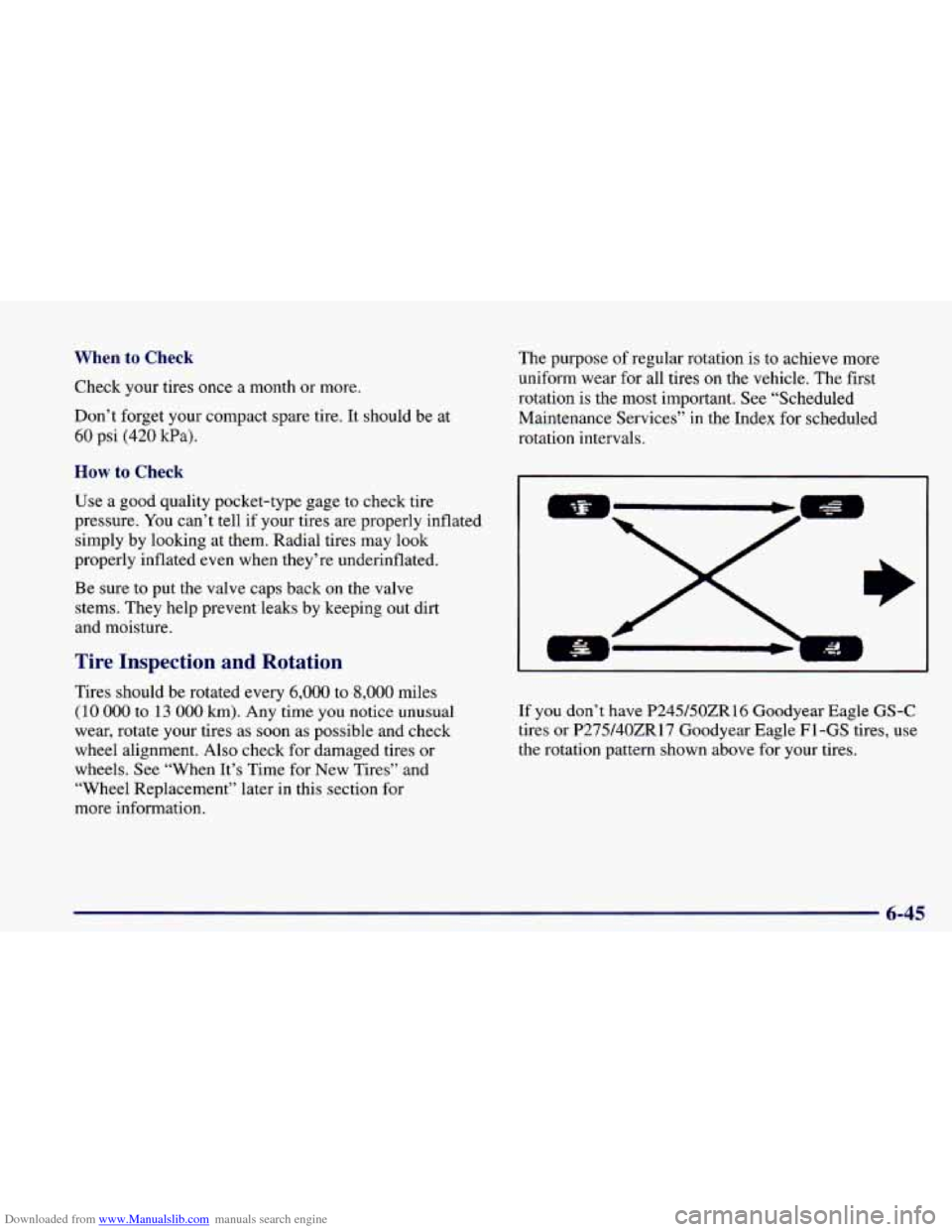
Downloaded from www.Manualslib.com manuals search engine When to Check
Check your tires once a month or more.
Don’t forget your compact spare tire. It should be
at
60 psi (420 kPa).
How to Check
Use a good quality pocket-type gage to check tire
pressure. You can’t tell if your tires are properly inflated
simply by lookrng at them. Radial tires may look
properly inflated even when they’re underinflated.
Be sure to put the valve caps back on the valve
stems. They help prevent leaks by keeping out dirt
and moisture.
Tire Inspection and Rotation
Tires should be rotated every 6,000 to 8,000 miles
(10
000 to 13 000 km). Any time you notice unusual
wear, rotate your tires as soon as possible and check
wheel alignment. Also check for damaged tires or
wheels. See “When It’s Time for New Tires” and
“Wheel Replacement” later in this section for
more information. The
purpose of regular rotation is to achieve more
uniform wear
for all tires on the vehicle. The first
rotation is the
most important. See “Scheduled
Maintenance Services” in the Index for scheduled
rotation intervals.
LA
If you don’t have P245/5OZR16 Goodyear Eagle GS-C
tires or P275/4OZR17 Goodyear Eagle F1-GS tires, use
the rotation pattern shown above for your tires.
6-45